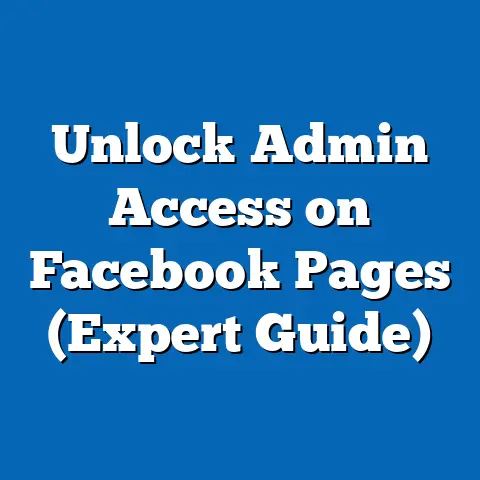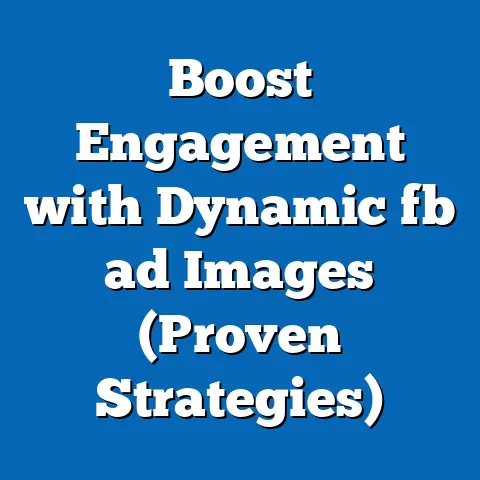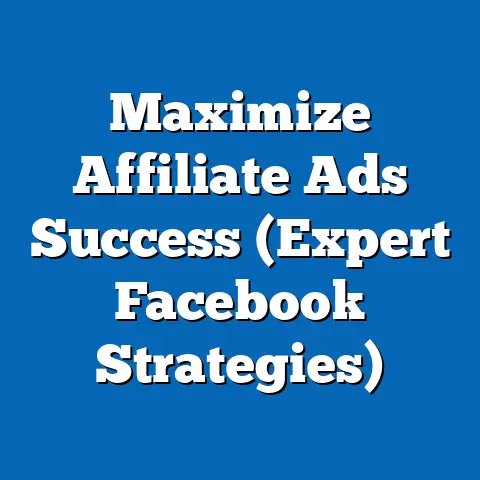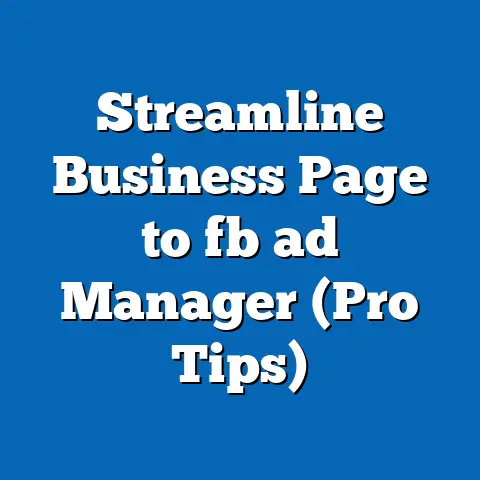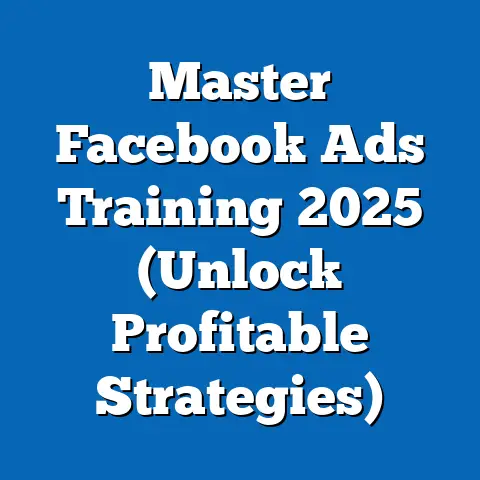Unlocking Look Up Ads on Facebook (Expert Strategies Revealed)
Imagine a world where your Facebook ads aren’t just seen, but actively sought out. A world where potential customers are almost waiting for your message. Sounds like a dream, right? Well, it’s closer to reality than you might think, thanks to a powerful but often overlooked tool: Look Up Ads on Facebook.
I’ve seen firsthand the incredible impact these ads can have. I remember working with a small e-commerce business struggling to break through the noise. They were spending money on traditional Facebook ads, but their ROI was lackluster. After implementing a carefully crafted Look Up Ads strategy, we saw their conversion rates jump by 40% in just a few weeks. The key? We tapped into user intent in a way they never had before.
Section 1: Understanding Look Up Ads
Let’s start with the basics. What exactly are Look Up Ads, and why are they different from the standard fare on Facebook?
What are Look Up Ads?
Look Up Ads, in essence, are a type of Facebook ad designed to capitalize on user intent. They’re triggered by specific user actions or searches within the Facebook ecosystem. Think of it this way: instead of passively scrolling through their feed and stumbling upon your ad, a user actively initiates the process by looking for something related to your product or service.
This distinction is crucial. Traditional Facebook ads often rely on demographic or interest-based targeting, hoping to catch the attention of users who might be interested. Look Up Ads, on the other hand, target users who are already expressing interest in a specific topic or category. This higher level of intent translates to a higher likelihood of engagement and conversion.
How They Differ from Other Ad Formats
Consider a typical news feed ad. It’s visually appealing, perhaps, and targets users interested in “hiking.” But the user might be scrolling through photos of their friends, reading news articles, or watching videos. Your ad is competing for their attention amidst a sea of distractions.
Now, imagine a user searching for “best hiking boots near me” on Facebook Marketplace. A Look Up Ad promoting your hiking boot store appears directly in their search results. The user is actively seeking information about hiking boots, making them far more receptive to your message.
The key difference lies in the context. Look Up Ads appear in moments of high intent, when users are actively seeking solutions or information related to your product or service. This contextual relevance significantly boosts their effectiveness.
The Mechanics of Look Up Ads
Look Up Ads operate within the broader framework of Facebook’s advertising platform, but they leverage specific features to target user intent. Here’s a breakdown of the key mechanics:
- Targeting Options: While you can still use demographic and interest-based targeting, the real power of Look Up Ads lies in keyword targeting and behavioral targeting. Keyword targeting allows you to show your ads to users who are searching for specific terms related to your business. Behavioral targeting lets you target users based on their past actions on Facebook, such as liking specific pages, joining relevant groups, or engaging with similar content.
- Ad Placements: Look Up Ads can appear in various locations on Facebook, including:
- Marketplace Search Results: This is a prime location for targeting users who are actively looking to buy or sell products.
- Facebook Search Results: When users search for businesses, services, or topics on Facebook, Look Up Ads can appear alongside the organic results.
- Suggested Results: Facebook’s algorithm suggests relevant businesses and services to users based on their past activity. Look Up Ads can appear in these suggested results.
- User Engagement: Look Up Ads are designed to be highly engaging. They typically feature compelling visuals, concise messaging, and clear calls to action. The goal is to capture the user’s attention and encourage them to take the next step, whether it’s visiting your website, contacting your business, or making a purchase.
- Marketplace Search Results: This is a prime location for targeting users who are actively looking to buy or sell products.
- Facebook Search Results: When users search for businesses, services, or topics on Facebook, Look Up Ads can appear alongside the organic results.
- Suggested Results: Facebook’s algorithm suggests relevant businesses and services to users based on their past activity. Look Up Ads can appear in these suggested results.
Who Benefits Most from Look Up Ads?
While Look Up Ads can be effective for a wide range of businesses, certain industries and business models tend to benefit the most. These include:
- Local Businesses: Restaurants, salons, auto repair shops, and other local businesses can use Look Up Ads to target users who are searching for their services in a specific geographic area.
- E-commerce Businesses: Online retailers can use Look Up Ads to promote their products to users who are actively searching for those items on Facebook Marketplace.
- Service Providers: Lawyers, accountants, consultants, and other service providers can use Look Up Ads to connect with potential clients who are seeking their expertise.
- Businesses with Niche Products or Services: If you offer a unique or specialized product or service, Look Up Ads can help you reach a highly targeted audience who is actively searching for what you offer.
Real-Life Examples of Successful Campaigns
Let’s look at a few examples of how businesses have successfully leveraged Look Up Ads:
- A local bakery: Used Look Up Ads to target users who were searching for “cake shops near me” on Facebook. They offered a special discount for first-time customers who found them through Facebook, resulting in a significant increase in orders.
- An online clothing retailer: Promoted their new line of summer dresses to users who were searching for “summer dresses” on Facebook Marketplace. They used high-quality images and compelling messaging to capture the user’s attention and drive sales.
- A law firm: Targeted users who were searching for “personal injury lawyer” on Facebook. They offered a free consultation to potential clients, resulting in a steady stream of new leads.
The Role of Consumer Intent
I can’t stress this enough: the magic of Look Up Ads lies in understanding and leveraging consumer intent. When users are actively searching for something, they’re in a different mindset than when they’re passively browsing. They’re actively seeking solutions, information, or products.
By targeting these users with relevant and compelling ads, you’re essentially answering their questions and providing them with the information they need to make a decision. This approach is far more effective than simply trying to interrupt their browsing with generic ads.
Data and Case Studies
Numerous studies have shown the effectiveness of intent-based advertising. For example, a study by Google found that users who search for a specific product or service are 50% more likely to make a purchase than users who simply browse related websites.
Similarly, a case study by Facebook found that businesses that used Look Up Ads to target users who were searching for specific products on Marketplace saw a 20% increase in sales compared to businesses that used traditional Facebook ads.
Key Takeaways
- Look Up Ads capitalize on user intent by targeting users who are actively searching for specific products or services.
- They differ from traditional Facebook ads by appearing in moments of high intent, leading to higher engagement and conversion rates.
- They are particularly effective for local businesses, e-commerce businesses, service providers, and businesses with niche offerings.
- Understanding and leveraging consumer intent is crucial for maximizing the effectiveness of Look Up Ads.
Next Steps:
Start brainstorming keywords and search terms that your target audience might use when looking for your products or services. This will be crucial when setting up your Look Up Ads campaign.
Don’t worry; it’s not as intimidating as it might seem.Step-by-Step Guide
-
Create a Facebook Business Manager Account:
If you don’t already have one, you’ll need to create a Facebook Business Manager account. This is the central hub for managing your Facebook pages, ad accounts, and other business assets. * Go to business.facebook.com and click “Create Account.” * Follow the prompts to enter your business information. * Once your account is created, you can add your Facebook page and create an ad account. 2. Navigate to Ads Manager:
Once you’re logged into Business Manager, navigate to Ads Manager. This is where you’ll create and manage your Facebook ad campaigns. * Click on the “Business Tools” icon in the top left corner. * Select “Ads Manager” from the dropdown menu. 3. Create a New Campaign:
In Ads Manager, click the “Create” button to start a new campaign. * You’ll be prompted to choose a campaign objective. This is where things get interesting for Look Up Ads. 4. Choose the Right Campaign Objective:
While Look Up Ads can be used with various campaign objectives, some are more suitable than others. I’ve found that these tend to work best: * Traffic: This objective is ideal for driving traffic to your website or landing page. It’s a good choice if you want to generate leads or promote specific products or services. * Engagement: This objective is designed to increase engagement with your ad, such as likes, comments, and shares. It’s a good choice if you want to build brand awareness or promote a contest or giveaway. * Leads: This objective allows you to collect leads directly from your ad. It’s a good choice if you want to generate sales leads or build your email list. * Sales: This objective is designed to drive sales of your products or services. It’s a good choice if you have an e-commerce store or offer online services. 5. Set Your Budget and Schedule:
Next, you’ll need to set your budget and schedule for your campaign. * You can choose between a daily budget or a lifetime budget. * You can also set a start and end date for your campaign, or run it continuously. * Consider starting with a smaller budget to test your ads and targeting before scaling up. 6. Define Your Audience:
This is where you’ll leverage Facebook’s targeting features to reach the right audience. As I mentioned earlier, the key to Look Up Ads is targeting users who are actively expressing interest in your product or service. Here’s how to do it: * Location Targeting: Specify the geographic area you want to target. This is particularly important for local businesses. * Demographic Targeting: Target users based on their age, gender, education, and other demographic factors. * Interest Targeting: Target users based on their interests and hobbies. This is a good way to reach users who are interested in a specific topic or category. * Behavioral Targeting: Target users based on their past actions on Facebook, such as liking specific pages, joining relevant groups, or engaging with similar content. This is a powerful way to reach users who are actively seeking information related to your business. * Keyword Targeting: This is the most crucial targeting option for Look Up Ads. Enter keywords and search terms that your target audience might use when looking for your products or services on Facebook. 7. Choose Your Ad Placement:
Select the ad placements where you want your Look Up Ads to appear. As I mentioned earlier, the most effective placements for Look Up Ads are: * Marketplace Search Results * Facebook Search Results * Suggested Results 8. Create Your Ad Creative:
Now it’s time to create your ad creative. This is where you’ll showcase your product or service and encourage users to take action. * Choose a compelling visual: Use a high-quality image or video that captures the user’s attention and showcases your product or service. * Write concise and engaging messaging: Clearly communicate the benefits of your product or service and explain why users should choose you over the competition. * Include a clear call to action: Tell users exactly what you want them to do, such as “Visit our website,” “Contact us today,” or “Shop now.” 9. Review and Publish Your Campaign:
Before you publish your campaign, take a moment to review all of your settings to ensure that everything is correct. * Once you’re satisfied, click the “Publish” button to launch your campaign.
Create a Facebook Business Manager Account:
If you don’t already have one, you’ll need to create a Facebook Business Manager account. This is the central hub for managing your Facebook pages, ad accounts, and other business assets. * Go to business.facebook.com and click “Create Account.” * Follow the prompts to enter your business information. * Once your account is created, you can add your Facebook page and create an ad account. 2. Navigate to Ads Manager:
Once you’re logged into Business Manager, navigate to Ads Manager. This is where you’ll create and manage your Facebook ad campaigns. * Click on the “Business Tools” icon in the top left corner. * Select “Ads Manager” from the dropdown menu. 3. Create a New Campaign:
In Ads Manager, click the “Create” button to start a new campaign. * You’ll be prompted to choose a campaign objective. This is where things get interesting for Look Up Ads. 4. Choose the Right Campaign Objective:
While Look Up Ads can be used with various campaign objectives, some are more suitable than others. I’ve found that these tend to work best: * Traffic: This objective is ideal for driving traffic to your website or landing page. It’s a good choice if you want to generate leads or promote specific products or services. * Engagement: This objective is designed to increase engagement with your ad, such as likes, comments, and shares. It’s a good choice if you want to build brand awareness or promote a contest or giveaway. * Leads: This objective allows you to collect leads directly from your ad. It’s a good choice if you want to generate sales leads or build your email list. * Sales: This objective is designed to drive sales of your products or services. It’s a good choice if you have an e-commerce store or offer online services. 5. Set Your Budget and Schedule:
Next, you’ll need to set your budget and schedule for your campaign. * You can choose between a daily budget or a lifetime budget. * You can also set a start and end date for your campaign, or run it continuously. * Consider starting with a smaller budget to test your ads and targeting before scaling up. 6. Define Your Audience:
This is where you’ll leverage Facebook’s targeting features to reach the right audience. As I mentioned earlier, the key to Look Up Ads is targeting users who are actively expressing interest in your product or service. Here’s how to do it: * Location Targeting: Specify the geographic area you want to target. This is particularly important for local businesses. * Demographic Targeting: Target users based on their age, gender, education, and other demographic factors. * Interest Targeting: Target users based on their interests and hobbies. This is a good way to reach users who are interested in a specific topic or category. * Behavioral Targeting: Target users based on their past actions on Facebook, such as liking specific pages, joining relevant groups, or engaging with similar content. This is a powerful way to reach users who are actively seeking information related to your business. * Keyword Targeting: This is the most crucial targeting option for Look Up Ads. Enter keywords and search terms that your target audience might use when looking for your products or services on Facebook. 7. Choose Your Ad Placement:
Select the ad placements where you want your Look Up Ads to appear. As I mentioned earlier, the most effective placements for Look Up Ads are: * Marketplace Search Results * Facebook Search Results * Suggested Results 8. Create Your Ad Creative:
Now it’s time to create your ad creative. This is where you’ll showcase your product or service and encourage users to take action. * Choose a compelling visual: Use a high-quality image or video that captures the user’s attention and showcases your product or service. * Write concise and engaging messaging: Clearly communicate the benefits of your product or service and explain why users should choose you over the competition. * Include a clear call to action: Tell users exactly what you want them to do, such as “Visit our website,” “Contact us today,” or “Shop now.” 9. Review and Publish Your Campaign:
Before you publish your campaign, take a moment to review all of your settings to ensure that everything is correct. * Once you’re satisfied, click the “Publish” button to launch your campaign.
The Importance of Audience Segmentation
I want to emphasize the importance of audience segmentation. Don’t just target everyone who might be interested in your product or service. Instead, segment your audience based on their interests, behaviors, and search terms.
For example, if you’re selling hiking boots, you might create separate ad sets for users who are interested in:
- Hiking
- Camping
- Outdoor recreation
- Specific hiking trails or destinations
This allows you to tailor your messaging and ad creative to each segment, making your ads more relevant and engaging.
Key Considerations for Ad Creative
Your ad creative is the first thing that users will see, so it’s crucial to make a good impression. Here are a few key considerations for creating effective Look Up Ads:
- Visuals: Use high-quality images or videos that are visually appealing and relevant to your target audience.
- Messaging: Write concise and engaging messaging that clearly communicates the benefits of your product or service.
- Call to Action: Include a clear and compelling call to action that tells users exactly what you want them to do.
- Relevance: Ensure that your ad creative is relevant to the search terms and interests of your target audience.
- Testing: A/B test different ad creatives to see what works best. Try different images, headlines, and calls to action.
Key Takeaways
- Setting up a Look Up Ads campaign involves creating a Business Manager account, navigating to Ads Manager, choosing the right campaign objective, defining your audience, choosing your ad placement, and creating your ad creative.
- Audience segmentation is crucial for targeting the right users with the right message.
- Your ad creative should be visually appealing, concise, engaging, and relevant to your target audience.
Next Steps:
Start creating your ad creative. Experiment with different images, headlines, and calls to action. Remember to keep your target audience in mind and tailor your messaging to their specific interests and needs.
Section 3: Expert Strategies for Optimization
Creating a Look Up Ads campaign is just the first step. The real magic happens when you start optimizing your campaign for better performance. I’ve spent years honing my optimization strategies, and I’m excited to share some of my top tips with you.
A/B Testing
A/B testing, also known as split testing, is a fundamental optimization technique. It involves creating two or more versions of your ad (A and B) and testing them against each other to see which performs better.
You can A/B test various elements of your ad, including:
- Headlines: Try different headlines to see which one captures the user’s attention and encourages them to click.
- Images: Test different images to see which one is most visually appealing and relevant to your target audience.
- Calls to Action: Experiment with different calls to action to see which one drives the most conversions.
- Audience Segments: Test different audience segments to see which one is most responsive to your ads.
To conduct an A/B test, create two versions of your ad with only one element different between them. For example, you might test two different headlines while keeping the image and call to action the same.
Run both ads simultaneously and track their performance. After a sufficient period of time (typically a week or two), analyze the results and identify the winning ad. Then, use the winning ad as the basis for your next A/B test.
Utilizing Facebook Pixel
The Facebook Pixel is a small piece of code that you can install on your website to track user actions. It allows you to track conversions, retarget users who have visited your website, and optimize your ads for better performance.
Here’s how to use the Facebook Pixel for Look Up Ads:
- Install the Pixel on Your Website: Follow Facebook’s instructions to install the Pixel on your website.
- Track Conversions: Set up conversion tracking to track specific actions that users take on your website after clicking on your ad, such as making a purchase, filling out a form, or signing up for a newsletter.
- Retarget Website Visitors: Create custom audiences based on users who have visited your website or specific pages on your website. Then, target these users with Look Up Ads to encourage them to return to your website and complete a purchase or take another desired action.
- Optimize for Conversions: Use the conversion data collected by the Pixel to optimize your ads for better performance. Facebook’s algorithm will automatically show your ads to users who are most likely to convert.
Analyzing Engagement Metrics
Facebook provides a wealth of data about how users are engaging with your ads. By analyzing these metrics, you can gain valuable insights into what’s working and what’s not.
Here are some key engagement metrics to track:
- Click-Through Rate (CTR): The percentage of users who click on your ad after seeing it. A high CTR indicates that your ad is relevant and engaging to your target audience.
- Conversion Rate: The percentage of users who complete a desired action (such as making a purchase or filling out a form) after clicking on your ad. A high conversion rate indicates that your landing page is effective and that your offer is compelling.
- Cost Per Click (CPC): The average cost you pay for each click on your ad. A low CPC indicates that your ad is efficient and that you’re getting good value for your money.
- Cost Per Conversion (CPC): The average cost you pay for each conversion. A low CPA indicates that your ad is effective at driving conversions and that you’re getting a good return on your investment.
- Relevance Score: Facebook assigns a relevance score to each of your ads based on how relevant and engaging it is to your target audience. A high relevance score indicates that your ad is well-targeted and that it’s resonating with users.
Adjusting Bids
Facebook uses an auction system to determine which ads to show to users. When you create a Look Up Ads campaign, you’ll need to set a bid, which is the maximum amount you’re willing to pay for each click or conversion.
If your ads aren’t performing well, you may need to adjust your bids. Here are a few tips:
- Increase Your Bids: If your ads aren’t getting enough impressions or clicks, try increasing your bids. This will increase your chances of winning the auction and getting your ads shown to more users.
- Decrease Your Bids: If your ads are getting a lot of impressions and clicks but not enough conversions, try decreasing your bids. This will lower your costs and improve your ROI.
- Use Automated Bidding: Facebook offers automated bidding options that can automatically adjust your bids based on your campaign goals. This can be a good way to optimize your bids without having to manually adjust them.
Continuous Monitoring and Adaptation
The key to successful Look Up Ads campaigns is continuous monitoring and adaptation. Facebook’s advertising platform is constantly evolving, and what works today might not work tomorrow.
It’s crucial to regularly monitor your campaign performance and make adjustments as needed. This might involve:
- Adjusting your targeting
- Updating your ad creative
- Changing your bids
- Testing new strategies
Insights from Industry Experts
I’ve learned a lot from my own experience, but I’ve also benefited from the wisdom of other industry experts. Here are a few insights from successful marketers who have mastered Look Up Ads:
- “Focus on providing value to your target audience. Don’t just try to sell them something; offer them helpful information or resources that will solve their problems.” – Neil Patel
- “Use Look Up Ads to build relationships with potential customers. Don’t just try to make a quick sale; focus on building trust and establishing yourself as an authority in your industry.” – Amy Porterfield
- “Test, test, test! The only way to know what works best is to experiment with different strategies and track your results.” – Gary Vaynerchuk
Key Takeaways
- A/B testing is crucial for optimizing your ad creative and audience segments.
- The Facebook Pixel allows you to track conversions, retarget website visitors, and optimize your ads for better performance.
- Analyzing engagement metrics provides valuable insights into what’s working and what’s not.
- Adjusting bids can help you optimize your costs and improve your ROI.
- Continuous monitoring and adaptation are essential for staying ahead of the curve.
Next Steps:
Start implementing these optimization strategies in your Look Up Ads campaigns. Track your results carefully and make adjustments as needed. Remember, the key to success is to continuously learn and adapt.
Section 4: Integrating Look Up Ads with Other Marketing Channels
While Look Up Ads can be incredibly powerful on their own, they’re even more effective when integrated with your other marketing channels. Think of it as creating a symphony of marketing efforts, where each channel complements and amplifies the others.
Complementing Other Digital Marketing Strategies
- Email Marketing: Imagine a user clicks on your Look Up Ad and visits your website but doesn’t make a purchase. You can then retarget them with a personalized email campaign, reminding them of the products they viewed and offering a special discount. This combination of Look Up Ads and email marketing can significantly boost your conversion rates.
- Content Marketing: Create valuable content that addresses the needs and interests of your target audience. Then, use Look Up Ads to promote your content to users who are searching for relevant topics on Facebook. This can help you attract new leads and build brand awareness.
- Social Media Engagement: Use Look Up Ads to drive traffic to your Facebook page or other social media profiles. This can help you build a larger and more engaged audience, which can then be targeted with organic content and other marketing efforts.
Benefits of a Multi-Channel Approach
A multi-channel approach offers several benefits:
- Increased Reach: By using multiple channels, you can reach a wider audience and increase your brand visibility.
- Improved Engagement: By tailoring your messaging to each channel, you can create more engaging and relevant experiences for your target audience.
- Higher Conversion Rates: By integrating your marketing channels, you can create a seamless customer journey that leads to higher conversion rates.
- Stronger Brand Loyalty: By providing consistent and valuable experiences across all channels, you can build stronger brand loyalty and customer relationships.
Examples of Successful Integration
Let’s look at a few examples of brands that have successfully integrated Look Up Ads with other marketing channels:
- A fitness studio: Used Look Up Ads to target users who were searching for “gyms near me” on Facebook. They then retargeted these users with email campaigns offering a free trial membership. They also used content marketing to create blog posts and videos about fitness tips and healthy recipes, which they promoted on Facebook and other social media channels.
- A travel agency: Used Look Up Ads to target users who were searching for “vacation packages” on Facebook. They then retargeted these users with personalized email campaigns offering special deals on specific destinations. They also used social media engagement to create contests and giveaways that encouraged users to share their travel experiences.
- A software company: Used Look Up Ads to target users who were searching for “project management software” on Facebook. They then retargeted these users with personalized email campaigns offering a free trial of their software. They also used content marketing to create blog posts and white papers about project management best practices, which they promoted on LinkedIn and other professional networking sites.
Key Takeaways
- Integrating Look Up Ads with other marketing channels can significantly amplify their effectiveness.
- A multi-channel approach offers several benefits, including increased reach, improved engagement, higher conversion rates, and stronger brand loyalty.
- Brands that successfully integrate Look Up Ads with other channels create a seamless customer journey and provide consistent, valuable experiences.
Next Steps:
Think about how you can integrate Look Up Ads with your other marketing channels. Consider your target audience, your campaign goals, and the specific strengths of each channel. Experiment with different strategies and track your results to see what works best.
Section 5: Measuring Success: Key Metrics and KPIs
You’ve set up your Look Up Ads campaign, you’re optimizing it for better performance, and you’re integrating it with your other marketing channels. But how do you know if it’s actually working? That’s where key metrics and KPIs come in.
Key Performance Indicators (KPIs) Relevant to Look Up Ads
KPIs are specific, measurable, achievable, relevant, and time-bound metrics that you can use to track the progress of your campaign and determine whether it’s meeting your goals.
Here are some key KPIs that are particularly relevant to Look Up Ads:
- Click-Through Rate (CTR): As I mentioned earlier, the CTR is the percentage of users who click on your ad after seeing it. A high CTR indicates that your ad is relevant and engaging to your target audience.
- Conversion Rate: The conversion rate is the percentage of users who complete a desired action (such as making a purchase or filling out a form) after clicking on your ad. A high conversion rate indicates that your landing page is effective and that your offer is compelling.
- Cost Per Click (CPC): The CPC is the average cost you pay for each click on your ad. A low CPC indicates that your ad is efficient and that you’re getting good value for your money.
- Cost Per Acquisition (CPA): The CPA is the average cost you pay for each conversion. A low CPA indicates that your ad is effective at driving conversions and that you’re getting a good return on your investment.
- Return on Ad Spend (ROAS): The ROAS is the amount of revenue you generate for every dollar you spend on advertising. A high ROAS indicates that your ad is profitable and that you’re getting a good return on your investment.
- Relevance Score: Facebook assigns a relevance score to each of your ads based on how relevant and engaging it is to your target audience. A high relevance score indicates that your ad is well-targeted and that it’s resonating with users.
Setting Benchmarks for Success
Before you start tracking your KPIs, it’s important to set benchmarks for success. These are the goals that you want to achieve with your Look Up Ads campaign.
Your benchmarks will depend on your specific business goals and industry. However, here are some general guidelines:
- CTR: Aim for a CTR of at least 1%.
- Conversion Rate: Aim for a conversion rate of at least 2%.
- CPC: Aim for a CPC that is lower than your average cost per customer.
- CPA: Aim for a CPA that is lower than your average customer lifetime value.
- ROAS: Aim for a ROAS of at least 3:1.
- Relevance Score: Aim for a relevance score of at least 7.
Tracking Metrics Over Time
It’s important to track your KPIs over time to see how your campaign is performing and identify areas for improvement.
You can use Facebook Ads Manager to track your KPIs. Ads Manager provides a wealth of data about your campaign performance, including impressions, clicks, conversions, cost per click, cost per acquisition, and return on ad spend.
You can also use third-party analytics tools to track your KPIs. These tools can provide more detailed insights into your campaign performance and help you identify trends and patterns.
Tools and Resources for Measuring Effectiveness
Here are some useful tools and resources for measuring the effectiveness of your Look Up Ads campaigns:
- Facebook Ads Manager: This is the primary tool for managing and tracking your Facebook ad campaigns.
- Google Analytics: This is a free web analytics tool that can provide detailed insights into your website traffic and user behavior.
- Kissmetrics: This is a paid analytics tool that can help you track user behavior across multiple channels.
- Mixpanel: This is a paid analytics tool that can help you track user engagement and identify key user segments.
Key Takeaways
- Key metrics and KPIs are essential for measuring the success of your Look Up Ads campaigns.
- Relevant KPIs include click-through rate, conversion rate, cost per click, cost per acquisition, return on ad spend, and relevance score.
- Setting benchmarks for success is important for determining whether your campaign is meeting your goals.
- Tracking metrics over time allows you to see how your campaign is performing and identify areas for improvement.
Next Steps:
Start tracking your KPIs and compare them to your benchmarks. Identify areas where your campaign is performing well and areas where it needs improvement. Use this data to make adjustments to your campaign and optimize it for better performance.
Conclusion
We’ve covered a lot of ground in this guide, from understanding the fundamentals of Look Up Ads to implementing advanced optimization techniques. I hope you now have a clear understanding of how to leverage this powerful ad format to achieve your business goals.
Recap of Key Strategies and Insights
Let’s recap the key strategies and insights we’ve discussed:
- Understand the Power of Intent: Look Up Ads capitalize on user intent by targeting users who are actively searching for specific products or services.
- Target the Right Audience: Use Facebook’s targeting features to reach the right audience with the right message.
- Create Compelling Ad Creative: Use high-quality visuals, concise messaging, and clear calls to action to capture the user’s attention.
- Optimize Your Campaign: A/B test different ad creatives and audience segments, utilize the Facebook Pixel, analyze engagement metrics, and adjust your bids accordingly.
- Integrate with Other Channels: Integrate Look Up Ads with your other marketing channels to create a seamless customer journey and provide consistent, valuable experiences.
- Measure Your Success: Track your KPIs and compare them to your benchmarks to see how your campaign is performing.
The Transformative Potential of Look Up Ads
Look Up Ads have the potential to transform your Facebook advertising efforts. By targeting users who are actively seeking your products or services, you can increase your engagement, drive more conversions, and generate a higher return on your investment.
A Call to Action
Now it’s time to take action. Implement the expert strategies we’ve discussed in this guide and explore the untapped potential of Look Up Ads on Facebook. Don’t be afraid to experiment, test new strategies, and track your results. The key to success is to continuously learn and adapt.
I encourage you to start today. Create your first Look Up Ads campaign, track your results, and see the difference it can make for your business. The world of Facebook advertising is constantly evolving, but one thing remains constant: the power of connecting with your target audience in a meaningful and relevant way. Look Up Ads can help you do just that. So, go out there and unlock their potential!

